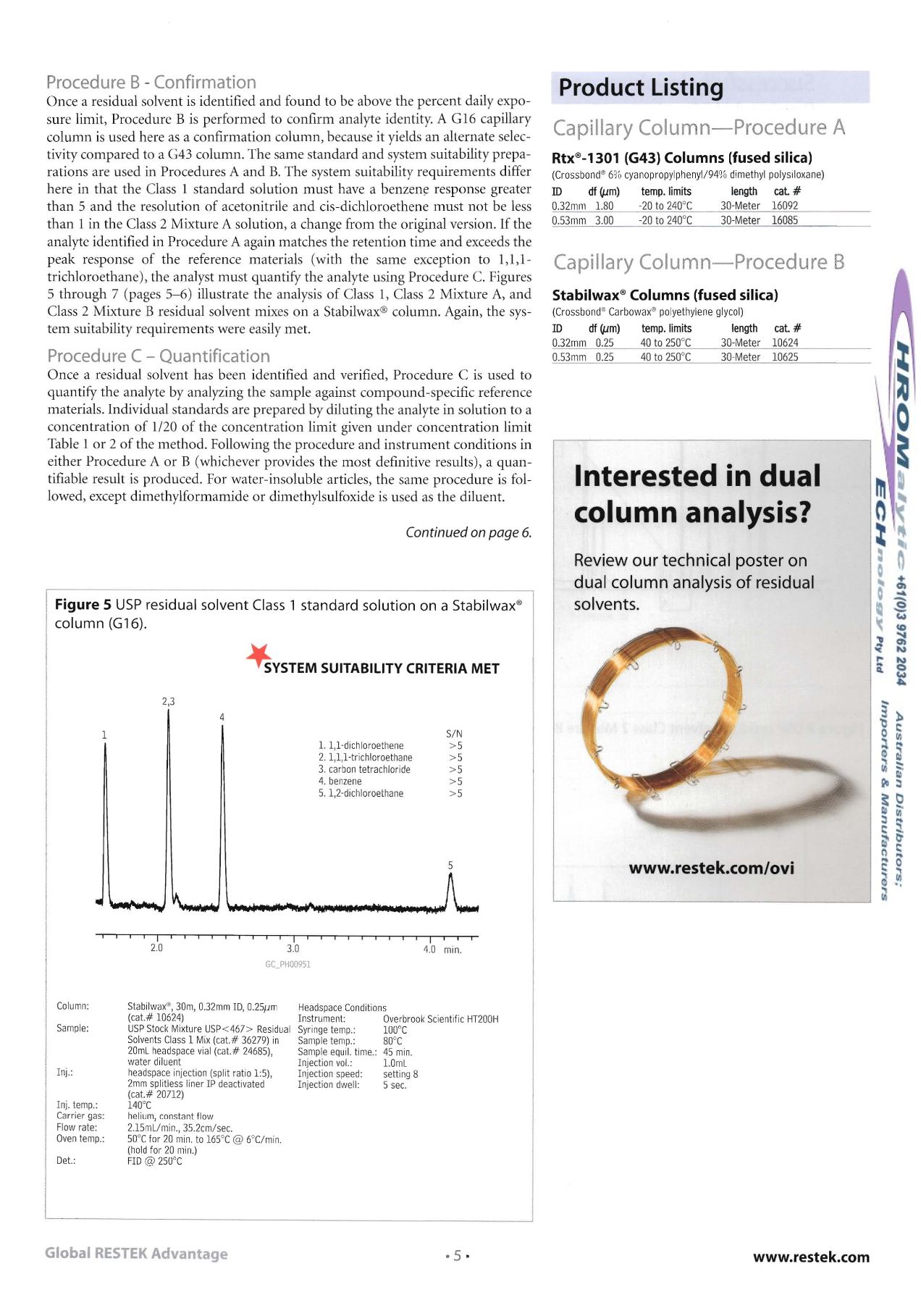

Procedure B- Confirmation
On ce a residual solvent is identifi ed and fou nd to be abov e th e percent daily expo
sure limi t, Procedur e B is performed to confirm analyte identity. A G16 capillary
column is used here as a confirmation column, because it yields an alternate selec
tivity compared to a G43 column. The same standa rd and system suitability pre pa
rations are used in Procedures A and B. The system suitability requirements differ
here in that th e Class 1 standard solution must have a benzene response grea ter
than 5 and the resolu tion of aceto nitrile and cis-di chloroeth ene must not be less
than 1 in th e Class 2 Mixture A solution, a change from the orig inal version. If th e
ana lyte identified in Procedure A again ma tches the retent ion time and exceeds the
peak respon se of the reference materials (with the same exceptio n to 1,1,1
trich loroeth ane), the analyst must quant ify th e analyte using Procedure
C.
Figures
5 th rou gh 7 (pages 5-6) illustr ate the analysis of Class I, Class 2 Mixture A, and
Class 2 Mixture B residu al solvent mixes on a Sta bilwaxv column. Again, the sys
tem suitability requireme nts were easily met.
Procedure C - Quantification
Once a residual solvent has been ident ified and verified, Procedure C is used to
qu antify the ana lyte by ana lyzing the sample against compo und-specific reference
materials. Indi vidu al standards are prepared by diluti ng the analyte in solution to a
concentra tion of 1/20 of the concentr atio n limit given under concentration limit
Table 1 or 2 of the method. Following the proce dure and instrument conditions in
either Procedure A or B (whichever prov ides the most definitive results), a quan
tifiable result is pro duced. For water-insolub le articles, th e same procedure is fol
lowed, except dimethylformamide or dimeth ylsulfoxide is used as the diluent.
Continued on page 6.
Figure 5
USP residual solvent Class 1 standard solution on a Stabilwa x"
column (G16).
-¥sYSTEM SUITABILITY CRITERIA MET
2,3
SIN
1.1,I ·dichloroethene
> 5
2.1,1,I ·trichloroethane
> 5
3. carbon tetrachloride
> 5
4. benzene
> 5
5. 1,2'dichloroethane
> 5
t
I
I
I
ii I
i
I
I
I
I
I
I
2.0
3.0
4.0 min.
GC_PH00951
Column:
Stabilwax",
30m, 0.32mm!D,
0.251lm
Headspace
Conditions
(cat.# 10624)
Instrument:
Overbrook Scientific HT200H
Sample:
USP Stock Mixture USP< 467> Residual Syringe temp.:
IOO' C
Solvents Class I Mix(cat.# 36279) in
Sample temp.:
80'C
20mLheadspace vial(cat.# 24685),
Sample
eqinl.
time.: 45 min.
water diluent
Injection vol.:
l.OmL
Inj.:
headspace injection(split ratio 1:5),
Injection speed:
setting8
2mmsplitless liner IPdeactivated
Injection dwell:
5 sec.
(cat.# 20712)
Inj. temp.:
140'C
Carrier gas:
helium, constant flow
Flow rate:
2.15mL/min.,
35.2cm/ sec.
Oventemp.:
50'C for 20min. to 165'C
@
6' C/min.
(holdfor 20 min.)
Del.:
F!D
@
250' C
Product Listing
Capillary Column-Procedure A
Rtx®-1301 (G43) Columns (fused silica)
(Crossbond" 6% cyanopropylphenyl/94% dimethyl polysiloxane)
ill
df
/J1m)
temp. limits
length cal
#
0.32mm 1.80
-20 to 240' C
30-Meter 16092
0.53mm 3.00
-20 to 240' C
30-Meter 16085
Capillary Column-Procedure B
Stabilwax"
Columns (fused silica)
(Crossbond" Carbowax"
polyethyleneglycol)
ill
df
/J1m)
temp. limits
length cal
#
0.32mm 0.25
40 to 250'C
30-Meter 10624
0.53mm 0.25
40 to 250' C
30-Meter 10625
Interested in dual
column analysis?
Review our technical poster on
dual column analysis of residual
solvents.
www.restek.com/oviGlobal RESTEK Advantage
·5 ·
www.restek.comWebsite :
www.chromtech.net.auE-mail :
info@chromatech.net.auTelNo : 03 9762 2034 . . . in AUSTRALIA











